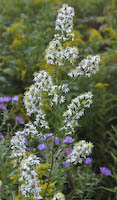Arrow-leaved Aster
Symphyotrichum urophyllum
(formerly Aster sagittifolius) |
 Other common names:
White Arrowleaf Aster Other common names:
White Arrowleaf Aster

Other scientific names:
Aster sagittifolius, Aster hirtellus, Aster urophyllus

Family:
Composite Family (Asteraceae)

Group:
Asters

Distinctive features:
Leaves are sort of arrow-shaped, without a deep cleft at base. Branches sweep upward, close to main stem.

Similar species:
•
Heart-leaved Aster (Symphyotrichum cordifolium) - Leaves larger and more heart-shaped.
•
Calico Aster (Symphyotrichum lateriflorum) - Same habitat, smaller plant, horizontal branches, smaller leaves.
•
Large-leaved Aster (Eurybia macrophylla) - In the woods; flower head is flat-topped; leaves are much larger.
•
Azure Aster (Symphyotrichum oolentangiense)

Flowers:
Summer, Autumn; White; 7 or more parts (petals); 1.5cm in diameter. Ray flowers: 8-15, usually white, sometimes pale pink or bluish. Disc flowers: 8-20, yellow becoming purple. Flower heads are a panicle shape. Many flowers are arrayed along upward sweeping branches.

Leaves:
Alternate, Simple; Sparse, arrow-shaped, but in the form of a spear point, not the form of -> or <-. Narrowly egg-shaped and shallowly toothed. Leaf stalks (petioles) winged. Lower leaves may be somewhat heart-shaped. Lower leaves are the largest.

Height:
40-100 cm (15-39 in)

Stem:
Smooth to somewhat hairy. Side branches are upward sweeping.

Habitat:
Fields and Open Areas, Meadows; Forest edges or dry open areas of woods. Widely distributed in southern Ontario.

Grows in Sun/Shade:
Sun

Lifespan:
Perennial.

Books:
Newcomb's Wildflower Guide: 454
Peterson's Field Guide to Wildflowers: 354

Native/Non-native:
Native

Status:
Very common.

Notes:
This Aster grows on the edges of forests. It is most easily confused with Heart-leaved Aster (Symphyotrichum cordifolium), which often grows very near or in the same area. It can also be confused with Calico Aster (Symphyotrichum lateriflorum) by the novice.

Photographs:
155 photographs available, of which 18 are featured on this page. SCROLL DOWN FOR PHOTOGRAPHS.

 |
 |
|
|
|
|
|
|
|
 |